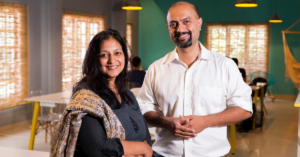The creative community has been a ripe target for startups building tools and services to serve their interests and needs as they transition from their traditionally offline practices into a digital present and future. In one of the latest developments, Domestika — a popular site that creates and sells online video tutorials and courses covering a range of visual arts and related skills, building a larger community around that content where members can also interact and learn from each other — has raised $110 million in funding on a $1.3 billion valuation.
This Series D is being led by Zeev Ventures, a longtime investor, with additional contributions from GSV and other unnamed, private investors, and it has now raised around $200 million to date. Its current valuation of $1.3 billion is a huge hike on its last round, in October 2021, when Domestika closed a modest $20 million Series C on a $350 million valuation, according to PitchBook data.
A lot is going into the logic behind those numbers. First of all is the size of the company today. Domestika currently offers more than 2,000 courses, created by 1,300 creative professionals, and it’s adding on average 110 new courses every month, covering subjects as diverse as crocheting techniques, painting animals, and editing for Instagram. It has more than 8 million members, and they have collectively taken more than 13 million courses.
“And those numbers are growing,” co-founder and CEO Julio G. Cotorruelo said in an interview, referring to the the courses, but also the company’s community of users. “It’s starting to be a big number. At this scale, no one is doing the amount of creative courses that we are.” The courses are produced by Domestika, but in conjunction with the teachers, “great professionals but maybe not great at producing an online course,” Cotorruelo said. “So we do it together. Then at the end of the day, the teachers are members of our community, too. The wheel never stops.”
There are courses presented in English, French, German and Italian, and additionally all courses feature subtitles in English, Spanish, Portuguese, German, Italian, French, Polish and Dutch.
Home sweet home
Started originally in Madrid as a modest (=small) online community for creatives, and then transplanted to the Bay Area (Berkeley, to be specific) when it decided to expand into online learning, Domestika has been somewhat under the radar. That’s largely, it seems, because it has never made an effort to talk much to the media or speak to much of anyone except those in its target community — my interview with Cotorruelo, the company told me, was one of the first and only interviews that he has ever done.
(Its name, by the way, was thought of by his co-founder, COO Tomy Pelluz, as a reference not to the domestic arts, but to feeling comfortable in the community. You are with your people, Cotorruelo said: “A home sweet home.”)
Domestika has been around for years — it was founded back in 2002 — but its focus and the attention it is getting right now taps into a couple of areas that have proven to be especially popular recently with users, and in turn, investors.
One important fact is how the community is organised around a shared interest, in this case artistic and creative output. At a time when many are turning away from large, general purpose social experiences in favor of smaller groups or groups based around specific interests, and in general more controlled environments where you are less likely to get harassed and perhaps you are less of a target for malicious hackers looking for the biggest impact, Domestika’s focus stands out. (In that regard, even Facebook has been pushing the idea of communities and groups, although I’d say, from my own experience, that its more open-ended DNA and sheer size makes keeping those communities focused is a daily chore for admins of those communities.)

Image Credits: Domestika
Another is the startup’s focus on e-learning. Education has been one of the most significant categories in the tech industry in the past couple of years. Traditional education providers (schools, colleges, universities, but also nurseries, professional training centers and really anywhere you might have gone for a class) all turning to remote collaboration services to continue teaching when the pandemic made in-person lessons impossible. But also, consumers — with a lot of their regular activities outside the home curtailed — all turned to doing more indoors, and self-improvement became a pretty huge theme, leading to record levels of traffic in areas like language learning, skills training and more.
Both of these played significantly into Domestika’s growth, and its attraction to investors.
It’s not the only company that has been focusing on building out services for the global community of creative professionals and enthusiasts. CreativeLive is another that has been focusing on educational content specifically for this segment of the market. Others like Superside are building tools to help its users connect with job opportunities, and then to manage those engagements and workflows through its platform. Much bigger players like Adobe have also created a strong platform also by building tools and community services for creatives, and you could imagine how it might eventually also build out more content, both based on its own tools but also more general skills, to keep those users engaged.
Domestika’s business model speaks of an interesting approach that also has played into its popularity.
Joining the Domestika community is free of charge, and users pay for courses, and those fees account for virtually all of Domestika’s revenues. (Note: some courses are free, too, tasters to get people interested in buying courses.) These courses are always sold a-la-carte, not on a monthly subscription.
“We don’t believe in an all you can eat model,” said Cotorruelo. :The nature of the commitment you take when you decide to take a course, it’s different from entertainment.” The pricing is on average between $10 and $15 per course, and for that you have access forever to that video and the community attached to the course, which can review your work and give you feedback when you want it. The system is sticky enough that two-thirds of Domestika’s 8 million users are active participants.
You can get certifications for certain courses, but that kind of professional development is not really the point, he said. “It is about joy and creativity,” Cotorruelo said, who emphasized that people mainly pay for and take courses on Domestika “because they like it. Sure, you might get a better job or make more money by knowing a new skill, but mainly this is about joy.”
And on the subject of jobs, recruitment and professional networking to pick up work is not something that Domestika has formally set up as part of its platform, although sometimes it happens by chance. There are no plans to do this, either, which is one way that this stands in contrast to, say, LinkedIn, which not only provides educational videos, but has recently built out exactly that kind of freelancer marketplace.
“At a time when it’s never been more vital for people to follow their passions and tap into their creativity, Domestika now has the scale to impact millions more around the world through its unique approach to education in creativity,” said Oren Zeev, founding partner at Zeev Ventures, in a statement. “Julio and his team have done an outstanding job in realizing their vision of building meaningful social learning experiences and bringing together curious minds from across the globe. I am excited to support the team as they continue to innovate and grow.”
“GSV Ventures is so proud to align with the team at Domestika, who prove every day that learning should be social, joyful, and beautiful” added Deborah Quazzo, managing partner at GSV Ventures. “Domestika is a game changer in how we approach learning and creativity, empowering 8 million learners, and more than 1300 teachers around the world to pursue their creative passions. We are excited about their opportunities to continue to grow and scale globally”.










